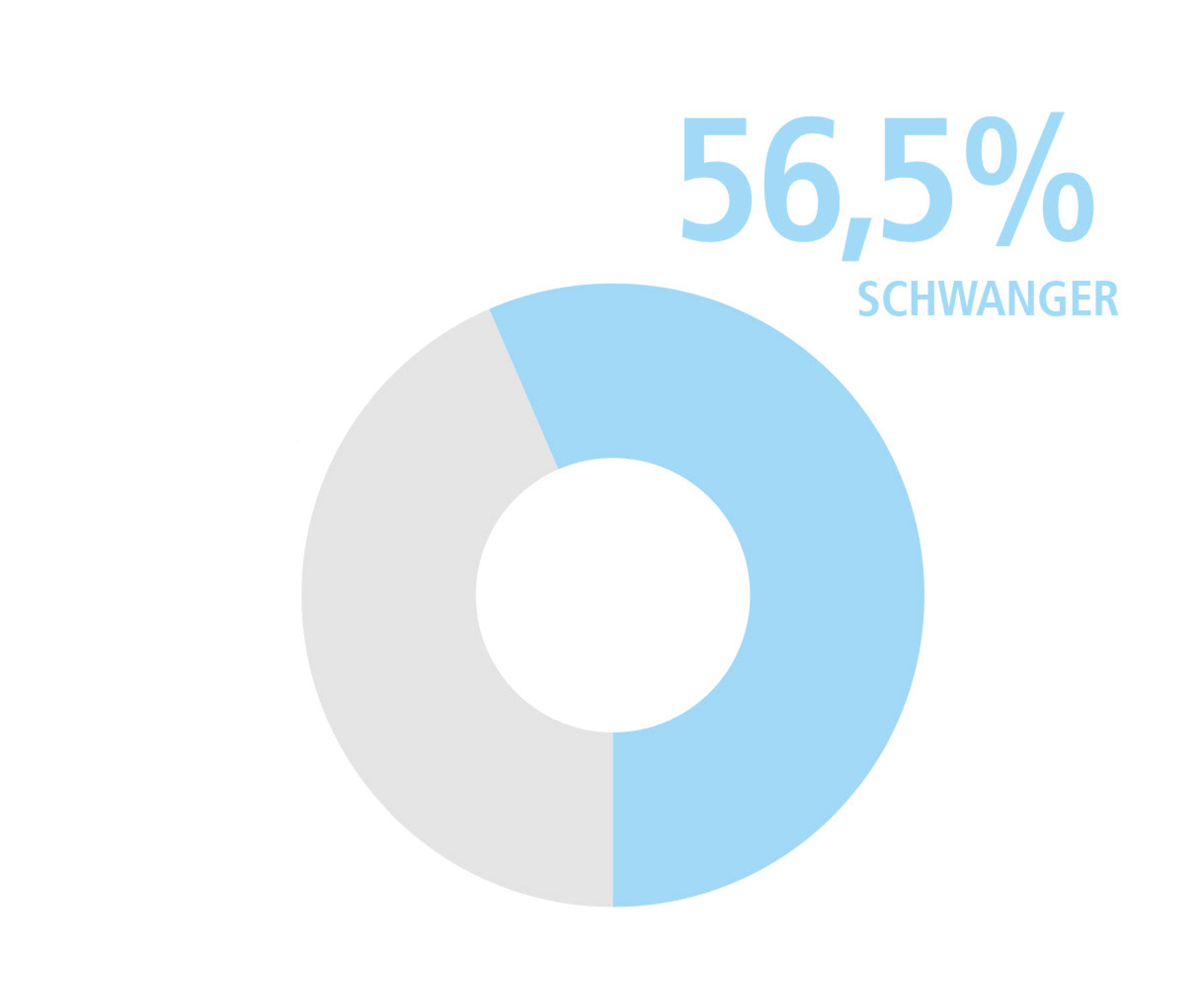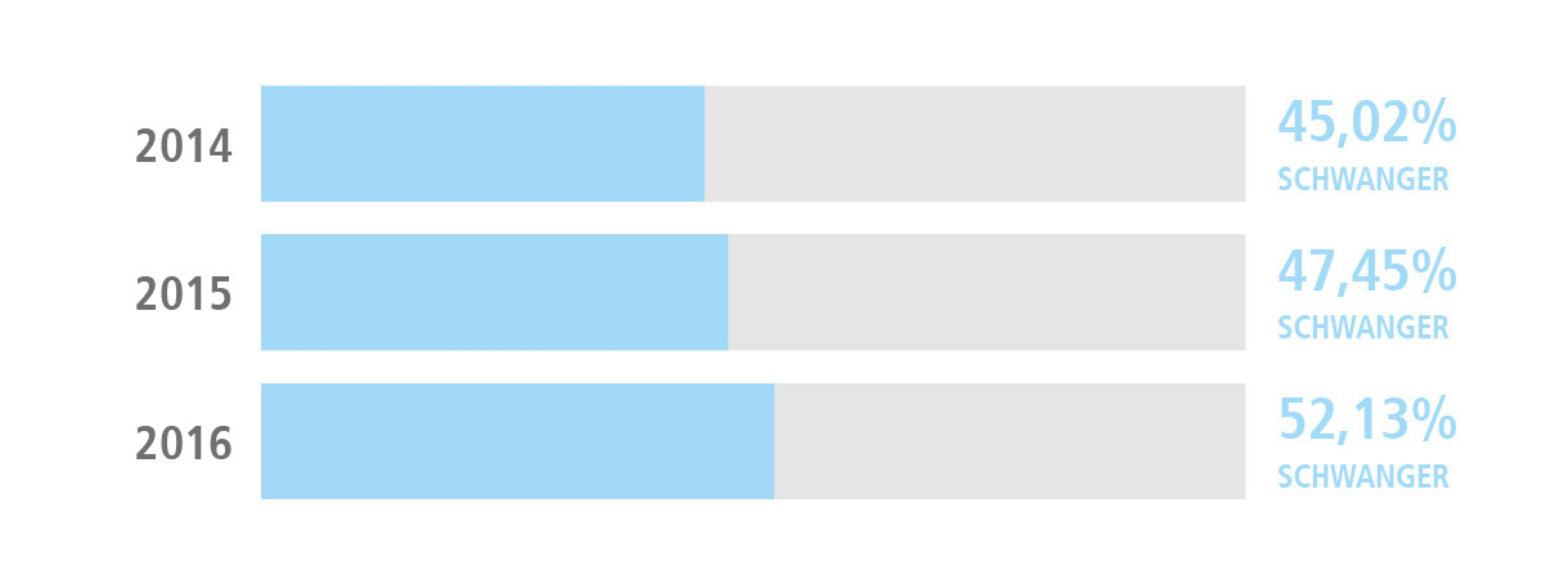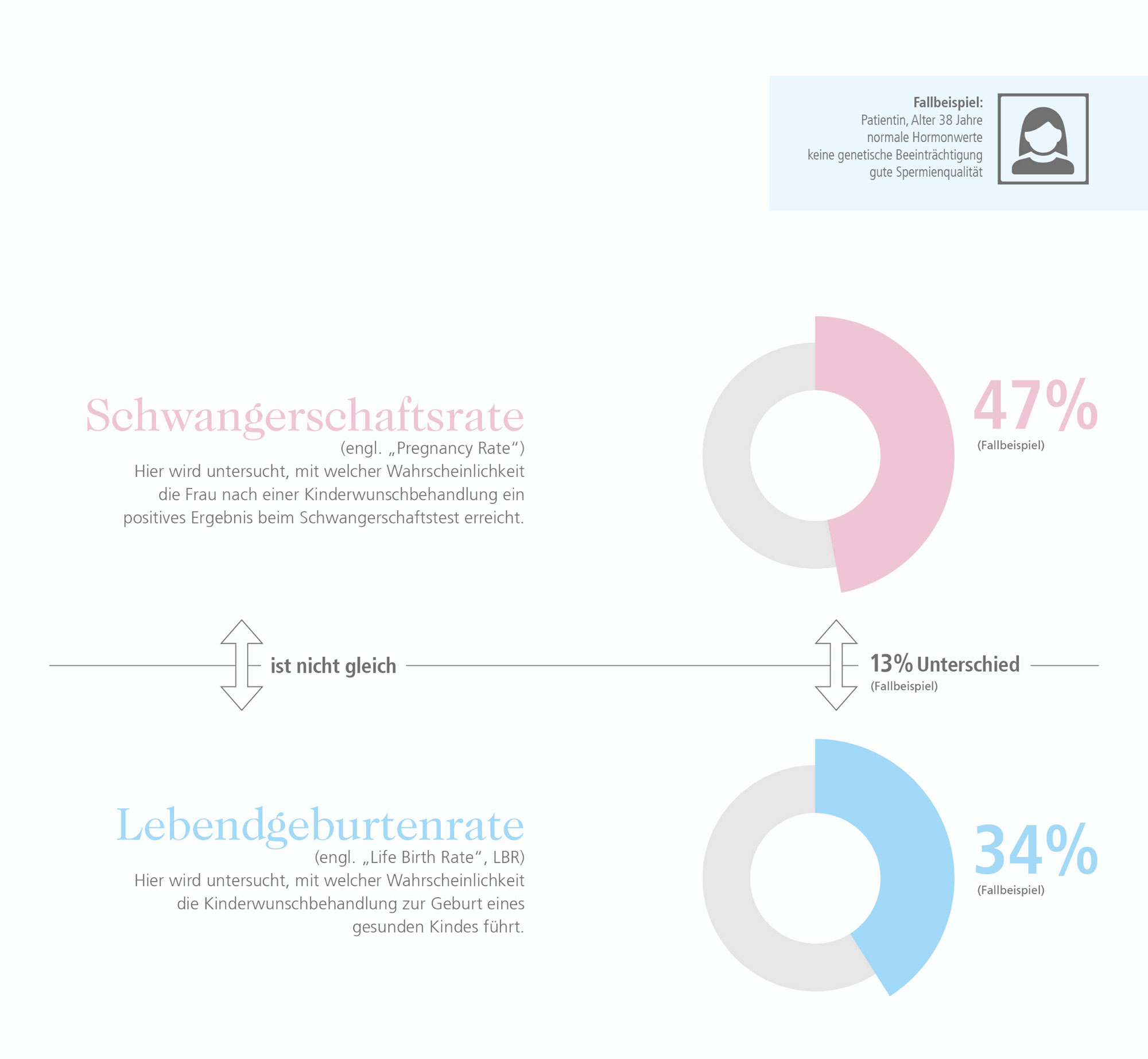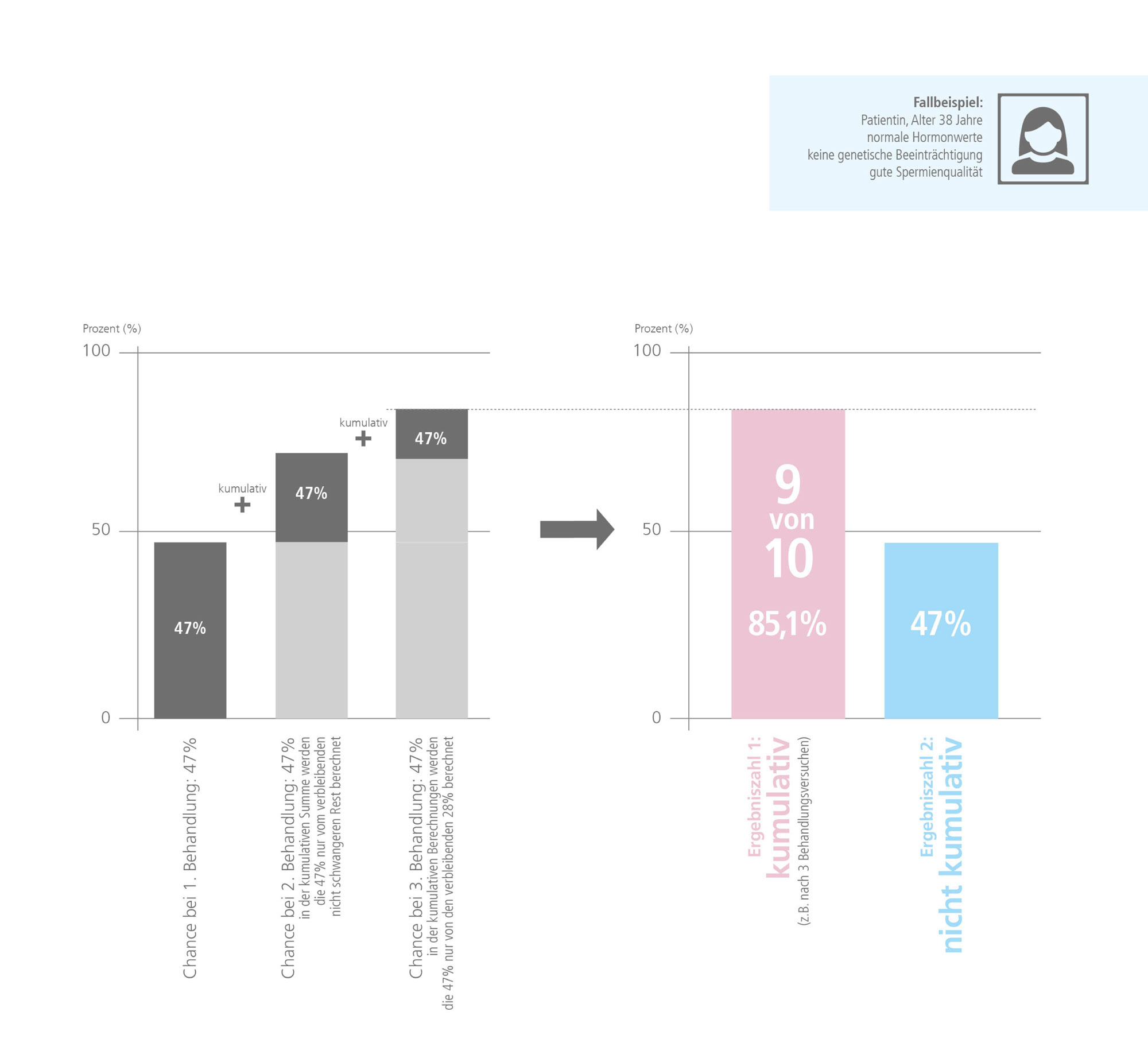Erfolgsrate
Erfolgsrate - Hintergründe
und Bedeutung
Etwa jedes fünfte Paar ist ungewollt kinderlos. Der Bedarf an professioneller medizinischer Unterstützung nimmt zu. Bei der Wahl des IVF-Zentrums bietet das Internet viele Möglichkeiten, um sich im Vorfeld darüber zu informieren, was das IVF-Zentrum anbietet, wie der Ablauf ist, wer die Therapie durchführt etc. Entscheidender ist jedoch für viele zu wissen, wie die jeweiligen Erfolgszahlen (z.B. Schwangerschaftsrate, Geburtenrate) aussehen:
Schwangerschaftsrate - Next Fertility IVF Prof. Zech
Anzahl der Frauen, die nach einem Versuch (Therapiezyklus) schwanger wurden (alle Altersgruppen, Transfer Top-Blastozysten):
Anzahl der Frauen, die nach einem Versuch (Therapiezyklus) schwanger wurden (Alter bis 37 Jahre, alle Transfers)
In manchen Ländern sind Kinderwunsch-Zentren per Gesetz dazu verpflichtet, die Ergebnisse zu veröffentlichen. Wo dies nicht vorgeschrieben ist, erfolgt die Angabe auf freiwilliger Basis. So gibt es immer wieder Fälle, in denen teilweise von Schwangerschaftsraten von über 90% die Rede ist, häufig verbunden mit der Botschaft, dass die Schwangerschaftsrate eine genaue Aussage über die Erfolgsaussichten bei einer Kinderwunschbehandlung darstellt. In unseren IVF-Zentren distanzieren wir uns von solchen Versprechungen. Den einen Erfolgsparameter gibt es nämlich nicht.
"... und was heißt das jetzt für uns?"
Diese Frage beschäftigt erfahrungsgemäß viele Paare, wenn sie die dargestellten Ergebnisse betrachten. Um eine Antwort darauf geben zu können, ist zunächst wichtig zu verstehen, dass der Grund für den unerfüllten Kinderwunsch meist eine Kombination aus verschiedenen Faktoren ist, wie z.B. Krankheiten, genetische Störungen, zunehmendes Alter, ungesunder Lebenswandel, schädliche Umwelteinflüsse. Die Erfolgschancen einer entsprechenden Kinderwunschbehandlung orientieren sich in erster Linie an der persönlichen Situation des Paares. Das bedeutet im Hinblick auf die veröffentlichten Therapie-Ergebnisse eines IVF-Zentrums, dass diese nicht auf jede/jeden Frau/Mann gleichermaßen zutreffen (z.B. Angabe Altersgruppe u. Schwangerschaftsrate) und daher differenziert betrachtet werden sollten. Dazu nachfolgend ein Fallbeispiel.
Schwangerschaft oder Geburt
Eine Schwangerschaft kann biochemisch bestimmt sein (über den Nachweis des Schwangerschaftshormons hCG = humanes Choriongonadotropin im Blut), oder visuell bestätigt werden (mittels Ultraschall, z.B. durch Nachweis des fötalen Herzschlags). Ist die Schwangerschaft visuell bestätigt, dann spricht man von einer klinischen Schwangerschaft(srate). Dies ist natürlich wünschenswert, jedoch bedeutet nicht jeder positive Schwangerschaftstest auch eine vitale Schwangerschaft die zur Geburt des Kindes führt (Lebendgeburtenrate). Die klinische Schwangerschaftsrate ist somit immer der zuverlässigere Parameter.
Kumulativ oder nicht kumulativ
Kumulativ leitet sich von dem lateinischen Wort "cumulare" (sich anhäufen) ab. Die kumulative Schwangerschaftsrate berücksichtigt die erzielten Schwangerschaften bei Kinderwunschbehandlungen nach mehreren, aufeinanderfolgenden Embryo-Transfers ("Frisch"- und Kryozyklen) und besagt, dass mit der Anzahl der absolvierten Therapien die Wahrscheinlichkeit schwanger zu werden zunimmt.
Die kumulative Schwangerschaftsrate kann auf unterschiedliche Art berechnet werden, ist schwer zu erfassen und verleitet auch zu Fehleinschätzungen. Es gibt z.B. keine übereinstimmende Meinung darüber, wie viele Versuche in eine kumulative Berechnung miteinbezogen werden sollen. Jede Kinderwunschbehandlung ist als "unabhängiges Ereignis" zu sehen. Es ist wie beim Würfeln. Die Chance eine 6 zu würfeln beträgt 1:6. Ist nach 5 Versuchen keine 6 gefallen, ist die Chance auf eine 6 im 6. Versuch aber immer noch 1:6 und nicht mehr.
Individuell abgestimmt Therapie erhöht Schwangerschafts-Chancen
Es gibt keine Garantie für den Erfolg einer Kinderwunschbehandlung. Aufgrund der intensiven Forschung auf dem Gebiet der Reproduktionsmedizin und der Entwicklung neuer Verfahren sind die Erfolgsaussichten heute aber deutlich höher als noch vor zehn Jahren. Grundsätzlich ist die Beurteilung der Chancen auf eine Schwangerschaft mittels Kinderwunschbehandlung immer in Bezug auf die persönliche medizinische Situation des Paares zu sehen. Besonders aufgrund der Tatsache, dass die Chancen, schwanger zu werden, von vielen Faktoren beeinflusst werden kann. Folgende Punkte stellen eine Auswahl an entscheidenden Aspekten dar, die wir in unseren IVF-Zentren zur Beurteilung einer realistischen Schwangerschafts-Chance pro Fall individuell in Betracht ziehen:
- Alter der Frau
- Art und Dauer der Unfruchtbarkeit
- Mögliche Vorerkrankungen
- Genetische Konstitution der Paare (balancierte Translokationen, genetische Erkrankungen etc.)
- ovarielle Reserve
- Qualität der Gameten (Eizellen u. Spermien)
- Qualität der transferierten Blastozyste(n)
- Kinderwunschbehandlung mit eigenen Eizellen/Spermien oder mit Spendereizellen/Spermien
- Auswahl des Stimulationsprotokolls
- Krankengeschichte (Anamnese)
- Risikofaktoren
- Reaktion auf vorangegangene Stimulationen
- BMI (Body-Mass-Index)
- Antraler Follikel-Count (AFC)
- Hormonstatus
- AMH-Wert etc.
Vor diesem Hintergrund basiert unser medizinisches Vorgehen auf individuell abgestimmten Therapieformen mit Detailanalysen und Auswahlmechanismen, durchgeführt von einem erfahrenen Team aus spezialisierten Ärzten, Biologen und Genetikern (mehr Infos).
Zur Erfüllung des Kinderwunsches ist für uns folgendes entscheidend:
Der Fokus auf die individuelle medizinische Situation des Paares in Verbindung mit unseren Möglichkeiten und fachlichen Leistungen.










